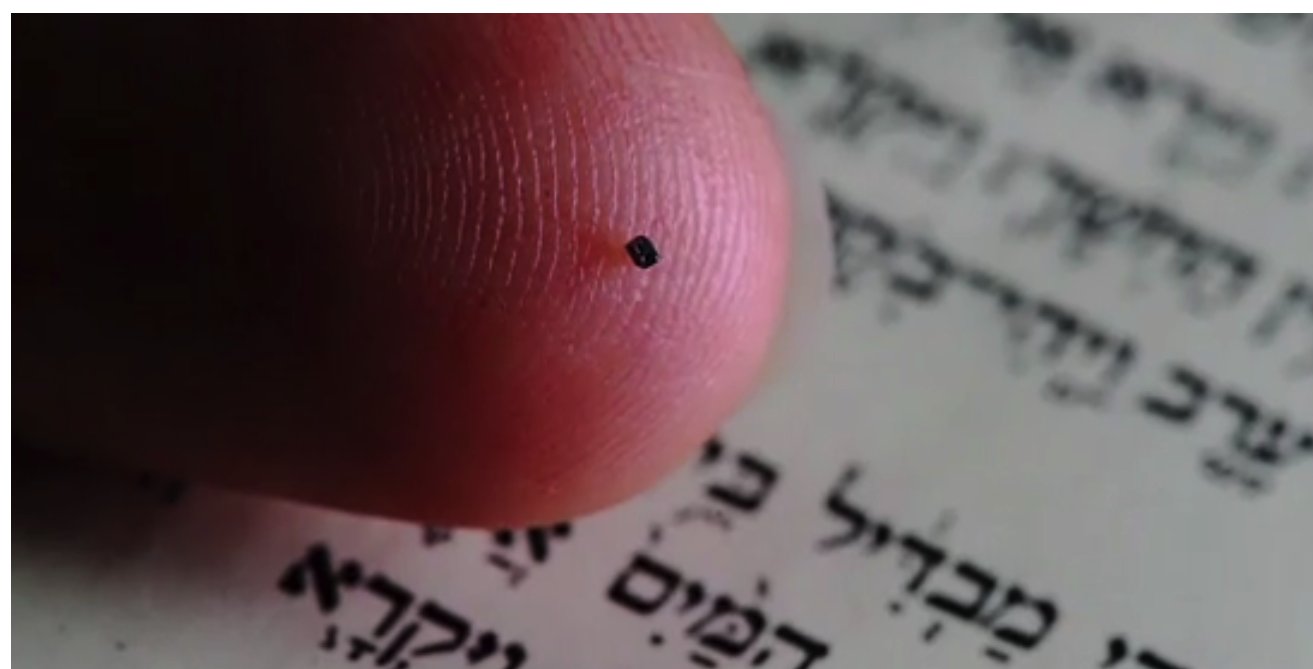World’s Smallest Hebrew Bible
No larger than a grain of sugar
This is a Press Release edited by StorageNewsletter.com on July 13, 2015 at 2:59 pmTwo special displays and a new exhibition space were inaugurated to commemorate the 50th Anniversary of the Shrine of the Book, home of the Dead Sea Scrolls and part of The Israel Museum, Jerusalem, which opened to the public in April 1965.
And Then There Was Nano: The Smallest Bible in the World, features the world’s tiniest version of the Hebrew Bible, created at the Technion-Israel Institute of Technology. The Nano Bible serves as a contemporary complement to the Dead Sea Scrolls, the oldest Biblical manuscripts in the world, providing audiences with a unique opportunity to examine the technological evolution of the Hebrew Bible from antiquity to the postmodern era.
On view concurrently, The Architecture of the Shrine of the Book is devoted to the unique history and design of the Shrine itself, an iconic work of modernist expressionist architecture, designed by Frederic Kiesler and Armand Bartos. Part of the Israel Museum’s anniversary celebrations throughout 2015, these special installations pay tribute to the Shrine of the Book’s opening in April 1965 as a prelude to the inauguration of the Museum’s entire campus.
The new exhibition space was inaugurated on April 20 with the display of And Then There Was Nano: The Smallest Bible in the World, revealing to the public for the first time the world’s smallest copy of the Old Testament. Developed by the Russell Berrie Nanotechnology Institute at the Technion in Haifa, the nano bible showcased in And Then There Was Nano is accompanied by the story of the world’s smallest Hebrew Bible etched onto a microchip no larger than a grain of sugar. The exhibition includes narrative presentations explaining the story behind the creation of the Nano Bible and detailed media through which the Hebrew Bible has been interpreted over time, tracing the path from the Biblical Nation to the Start-Up Nation.
“This exhibition writes a new chapter in the journey of the Book of Books from antiquity to the present – from the 2,000-year-old Dead Sea Scrolls to the 21st-century Nano Bible,” said James S. Snyder, Anne and Jerome Fisher, directors, Israel Museum. “This remarkable technological achievement will bring to a broad audience the context of the narrative of the Shrine of the Book and of the history of Biblical text from the ancient Dead Sea Scrolls to the most cutting-edge technology. It also marks a joint celebration with the Technion, whose Russell Berrie Nanotechnology Institute created the Nano Bible to mark the 50th Anniversary year of the Shrine and of the Museum.”
“Technion is delighted to partner with the Israel Museum, and to take part in its 50th anniversary celebrations,” said Technion president, Prof. Peretz Lavie. “The Nano Bible exhibition is a fascinating confluence of history, culture and cutting edge science – where the Land of the Bible meets the Start-Up Nation.”
What is the Nano Bible?
The Nano Bible is a gold-plated silicon chip the size of a pinhead on which the entire Hebrew Bible is engraved. The text, consisting of over 1.2 million letters, is carved on the 0.5mm² chip by means of a focused ion beam. The beam dislodges gold atoms from the plating and creates letters, similar to the way the earliest inscriptions were carved in stone. The writing process takes about an hour and a half. The letters belong to a font unique to this technology and appear darker against their gold background. In order to read the text, it is necessary to use a microscope capable of 10,000 times magnification or higher.
Employing a modern incarnation of an ancient writing technique, this technological marvel demonstrates the wonders of present day miniaturization and provides the spectator with a tangible measure of the achievable dimensions. Dense information storage is not unique to human culture: The blueprints of all organisms are stored by nature at even higher densities in long DNA molecules and transmitted in this form over generations.
The term ‘nano’ derives from the Greek word nanos, meaning ‘dwarf.’ The unit nm measures one billionth of a meter, a ratio similar to the size of an olive compared with the entire planet earth. Nanotechnology makes it possible to construct new materials stronger and lighter than steel, to desalinate water more efficiently, to deliver medications to designated parts of the body without harming surrounding tissues, and to detect cancerous cells in early stages. At the dawn of the Nano Age, scientists and engineers are discovering ways to harness such exquisite control over the elementary building blocks of nature for the benefit of mankind and our planet.













 Subscribe to our free daily newsletter
Subscribe to our free daily newsletter
